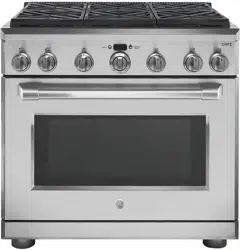Documents: Go to download!
User Manual
- User Manual - (English, French, Spanish)
- Dimension Guide - (English)
- Specification - (English)
- Installation Instruction - (English)
- USING THE RANGE
- CARE AND CLEANING
- TROUBLESHOOTING TIPS
Table of contents
User Manual Ranges
USING THE RANGE
Features of Your Range
Design information
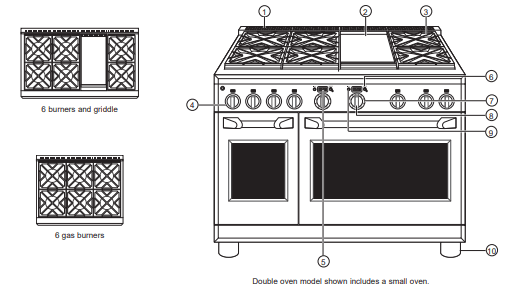
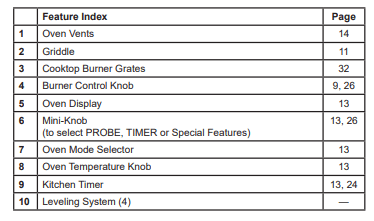
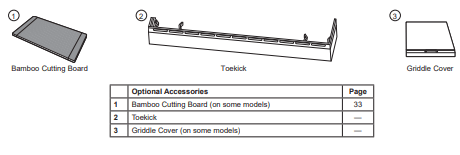
Cooktop Controls
Electronic Ignition and Automatic Reignition
The range is equipped with electronic ignition which eliminates the need for a standing pilot light. The burners on this range will automatically relight if the flame goes out. All surface burner igniters will spark and make clicking sounds when any burner is turned on. Do not touch any of the burners when igniters are clicking. Occasionally the burners may spark if excess wind or a draft blows the flame away from the burner’s flame sensor.
In case of a power outage, you can light the surface burners on your cooktop with a match. Hold a lighted match to the burner, then turn the knob to the LOW position. Use extreme caution when lighting burners this way.
Do not attempt to light the griddle during a power outage. The gas to these burners will automatically shut off during a power outage.
To Light a Surface Burner
Push the control knob in and turn it counterclockwise to the LITE position

After the burner ignites, turn the knob to adjust the flame size.
To turn a burner off, turn the knob clockwise, as far as it will go, to the OFF position.
- Do not operate a burner for an extended period of time without cookware on the grate. The finish on the grate may chip without cookware to absorb the heat.
Dual-flame Stacked Burners
All surface burners on your range have two sets of flames stacked one on top of the other; the dual-flame burners have a lower (simmer) flame and a upper (main) flame. When a burner is turned on, the lower flame will always light and stay on.
Simmering:
The stacked burner design provides a wide range of heat settings with which to simmer. Depending on the type and quantity of food, and pan size, the flame can be adjusted to suit your specific need. The lowest setting uses only the lower flame and can maintain delicate foods at a safe 140°F.
Cooking:
Settings from LO to X-HI will use both upper and lower flames. Use LO to HI for all purpose cooking. Use HI or X-HI (highest setting) with larger diameter cookware.
X-HI and HI are very high heat settings and are intended to sear foods quickly and boil large quantities of water.

Surface Cooking
How to Select Flame Size
Watch the flame, not the knob, as you increase or reduce heat. The flame size on a gas burner should match the cookware you are using. FOR SAFE HANDLING OF COOKWARE, NEVER /(77+()/$0((;7(1'837+(6,'(62)7+( COOKWARE. Any flame larger than the bottom of the cookware will not result in faster heating and could be hazardous.
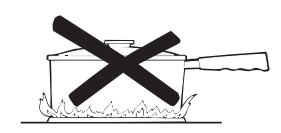
For surface stability, 6” minimum diameter cookware is recommended. Use larger diameter cookware for heat settings between HI and X-HI.
Wok Cooking
The burner grates are uniquely designed to cook on either side. The flat side accommodates flat-bottom cookware (stockpots, saucepans, frying pans, and flat-bottom woks), while the wok side is designed to hold a wide variety of round bottom works without the need for a separate ring.
For easy access, a front burner location is recommended for wok cooking.
The front center burner is recommended for wok cooking
on 6-burner 36" and 48" ranges.
Do not use a wok support ring. Placing the ring over the burner or grate may cause the burner to work improperly, resulting in carbon monoxide levels above allowable standards. This could be hazardous to your health.
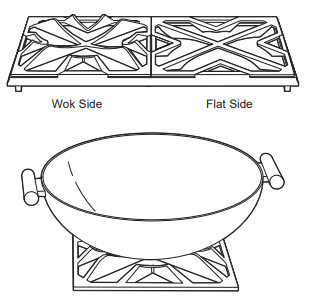
Griddle Safety Precautions, Leveling (on some models)
Remove the metal cover and the cutting board before turning the griddle on. The griddle assembly should not be removed for cleaning. Once the unit is in position, the griddle can be leveled. Remove the flue cover by lifting it straight up. Be careful not to scratch the surrounding stainless steel surfaces during removal of the flue cover. The two inner screws are clamping screws for securing the griddle in place. Loosen these two screws before leveling. Do not remove these two screws. The two outer screws are leveling screws. Do not remove these two screws. They can be turned to level the griddle or to provide a forward slope to help grease and oils to drain away from the food being cooked. After the first few uses, you will be able to judge the slope best suited for the foods you are cooking and personal preference.

After leveling the griddle, tighten the clamping screws to secure the griddle in place. Hand-tighten screws; do not over-tighten
Using the Griddle
Clean the griddle thoroughly with hot soapy water before first use and after subsequent uses. The griddle surface is made of durable, highly polished Type 304 stainless steel backed by an aluminum plate for even heat distribution. Apply a light coating of cooking oil to the griddle surface to help prevent food from sticking.
To heat the griddle, push in and turn the control knob to the desired temperature setting. The light on the bezel will glow to indicate that the thermostat control is working. The griddle is thermostatically controlled and
can be set to maintain any temperature from 200°F to 450°F. Permit the griddle to preheat for 10 minutes before placing food on it.
NOTE: Unlike the surface burners which use spark igniters, the griddle uses a Glo-Bar for ignition. Gas flows to the griddle burner and ignition occur approximately 45 seconds after the control knob is turned to a set temperature.
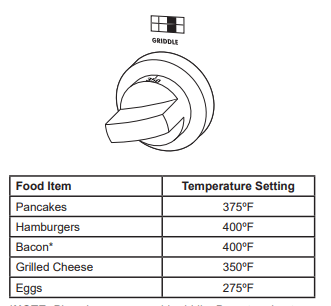
Design Information
NOTE: Not all features are on all models.
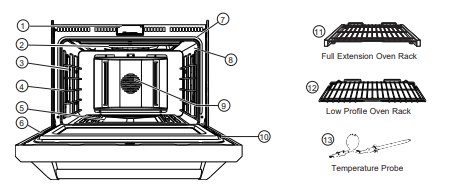

NOTE: On models equipped with 2 ovens, both ovens have same features.
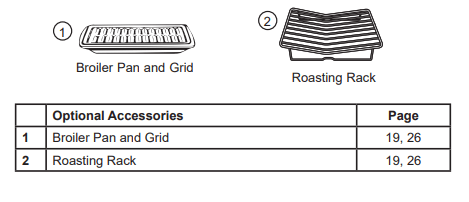
Oven Control
Features of Your Oven Control and Timer
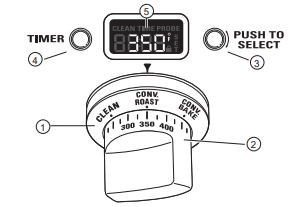
1. Oven Mode Selector - Turn outer ring to select:
PROOF - Maintains a warm environment useful for rising yeast-leavened products.
BAKE - Select for traditional baking.
CONV BAKE - Use for convection baking.
CONV ROAST - Use for convection roasting.
BROIL - Select for broiling.
CLEAN - Select for the self-cleaning function. See the Self-Cleaning Oven section.
2. Temperature Knob - Turn to select:
Temperatures from 175°F to 550°F.
LOW BROIL - A lower broiling temperature is automatically set.
HIGH BROIL - A higher broiling temperature is automatically set.
CLEAN - The self-clean temperature is automatically set.
3. Mini-Knob – Turn to select and push to enter
PROBE or TIMER settings. Also to adjust CLEAN
cycle time.
4. Timer Button – Push to select the kitchen timer
function. The timer does not control oven operations.
5. Oven Display – Displays oven functions such as
oven and probe temperatures and kitchen timer.
The Oven Mode Selector (1) AND the Temperature Knob (2) must be set together in one of the following valid pairings:
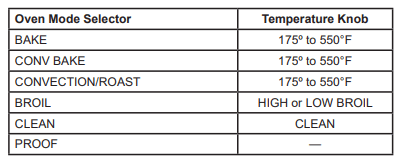
To cancel a feature, turn either the Oven Mode Selector or the Temperature knob to OFF.
To cancel PROOF, turn the Oven Mode Selector to OFF.
Baking Tips
Rear Oven Vents
An internal cooling fan operates during all oven modes. The warm air from the oven is exhausted through vents located at the rear of the cooktop. Do not allow the airflow from the rear vents to be obstructed by cookware or towels.
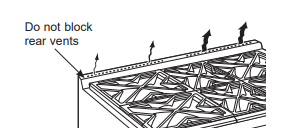
Aluminum Foil and Oven Liners
CAUTION : Do not use any type of foil or oven liner to cover the oven bottom. These items can trap heat or melt, resulting in damage to the product and risk of shock, smoke, or fire. Damage from improper use of these items is not covered by the product warranty.
Foil may be used to catch spills by placing a sheet on a lower rack, several inches below the food. Do not use more foil than necessary and never entirely cover an oven rack with aluminum foil. Keep foil at least 1-1/2” from oven walls to prevent poor heat circulation.
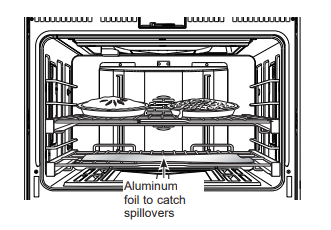
Pan Placement
For even cooking and proper browning, there must be enough room for air circulation in the oven. Baking results will be better if baking pans are centered as much as possible rather than being placed to the front or to the back of the oven.
Baking Pans/Sheets
Use the proper baking pan. The type of finish on the pan effects the amount of browning that will occur.
- Dark, rough or dull pans absorb heat resulting in a
- Glass baking dishes also absorb heat. When baking in
browner, crisper crust. Use this type for pies. glass baking dishes, the temperature may need to be - Shiny, bright and smooth pans reflect heat, resulting in reduced by 25 F. a lighter, more delicate browning. Cakes and cookies
require this type of pan or sheet
Preheating
Allow the oven to preheat before placing food in the
oven. Preheating is necessary for good results when
baking cakes, cookies, pastries, and bread.
Oven Racks
Full Extension Oven Racks
CAUTION : To avoid possible burns, place the racks in the correct position before turning on the oven. The correct rack position depends on the kind of food and the browning desired.
The racks have a frame that locks into the rack supports on both sides. Once the frame is locked into place, always pull the rack out, by its upper front rail, to its full extension stop position, when placing or removing cookware
Remove and Replace Oven Racks
To remove a rack:
1. Make sure the rack is pushed all the way into the oven.
2. Grasp the rack by both its upper front rail and its lower front rail and lift straight up to unlock the front rack locks from the rack supports

3. Firmly holding onto both the upper and lower front rack rails, pull the rack forward and remove it from the oven.
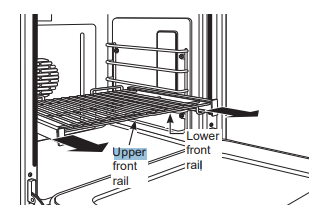
To replace a rack:
1. Place the rear rack locks over and onto the rack supports (five rack positions are available including the top position).
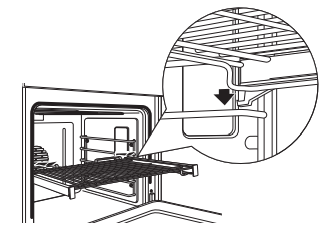
2. Slide the rack all the way in until the rear rack locks are secure on the rear rack supports and press the front rack locks onto the front rack supports
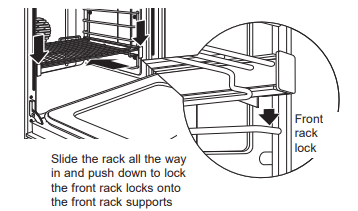
3. Pull the rack all the way out to check that it is properly engaged.
Low Profile Oven Rack
The low-profile oven rack is designed for optimized performance when baking or broiling certain foods in your Professional All-Gas range. It can also be used as a normal oven rack with the full extension oven racks as well.
Please refer to the oven rack position table for your bake/broil/convection mode for details as to location and rack type for the best performance.
Baking
How to Set the Oven for Baking
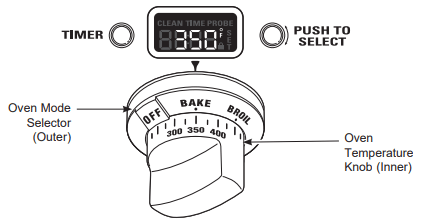
1. Turn the Oven Mode Selector to BAKE.
2. Using the Temperature knob, set the desired temperature, in 25°F increments, from 175°F to 550°F.
The oven will now begin to preheat. The temperature display will begin at 100°F and remain there until the oven exceeds that temperature. From that point, the display will show the actual temperature.
The interior lights will turn on and stay on until the oven is turned off. The convection oven fan will turn on temporarily during preheat. The control will beep when the oven is preheated and food can now be placed inside the oven.
3. Turn the Oven Mode Selector and the Temperature knob to OFF when baking is finished.
NOTE: A cooling fan will turn on to cool internal parts. This is normal, and the fan may continue to run even after the oven is turned off.
Use the temperature probe when a precise internal temperature is important. See Using the probe.
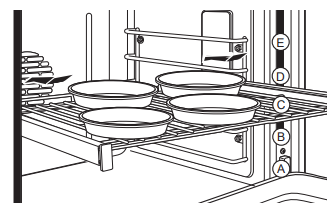
For best results when baking four cake layers at one time, place four pans on one shelf using the center
position C. Place the pans so each has at least 1-1/2” air space around it.
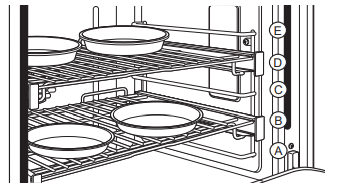
Or, place four pans using racks B and D. Stagger the pans so that one pan is not directly above another as shown above. The oven has 5 rack positions. See the Full extension oven racks section for how to use, remove and replace the racks. The double oven range has a small oven with 4 rack positions. Rack position C is not in the small oven.
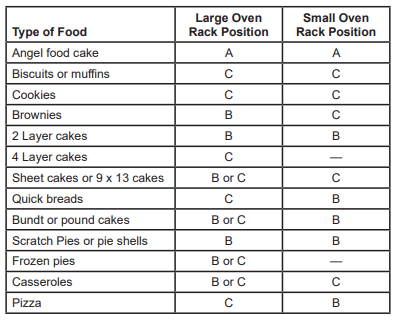
Suggested shelf positions are intended as general guidelines. Experiment with these positions for specific foods and personal preference.
Broiling
Introduction to Broiling
The broil mode has 2 settings. Choose HI or LO setting.
- The HI setting can be used to seal in juices or provide intense browning or charring when needed for foods such as hamburgers, roasted vegetables, whole peppers, eggplant, corn, assorted cut vegetables, kabobs and very thin meats such as smoked pork chops, London broil and chicken.
- The LO setting can be used for foods that need adequate browning and also need to be thoroughly cooked, like fish fillets, pork tenderloin and beef roast.
How to Set the Oven for Broiling

1. Turn the Oven Mode Selector to BROIL
2. Turn the Oven Temperature Knob to LO BROIL or HI BROIL. LO or HI will appear in the display.
NOTE: Always broil with the door closed. If the door is left open, the display will scroll “CLOSE door” and the elements will not turn on until the door is shut.
The oven interior lights will turn on and stay on until the oven is turned off.
3. When broiling is finished, turn the Oven Mode Selector and the Temperature knob to OFF.
NOTE:
- A cooling fan will turn on to cool internal parts. This is normal, and the fan may continue to run even after the oven is turned off.
- Broil will not work if the temperature probe is plugged in. Never leave your probe inside the oven during a broil cycle.
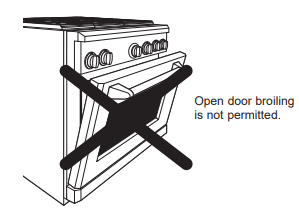
Broiling Guide
Due to the variety of of meats and cuts available, you may select alternate rack positions based on personal preferences of doneness and external searing. For
optimal searing, preheat oven for 5-10 minutes.
The size, weight, thickness, starting temperature and your preference of doneness will affect broiling times. This guide is based on meats at refrigerator temperature.

NOTE: In general, higher rack positions yield darker external searing and lower positions yield more doneness.
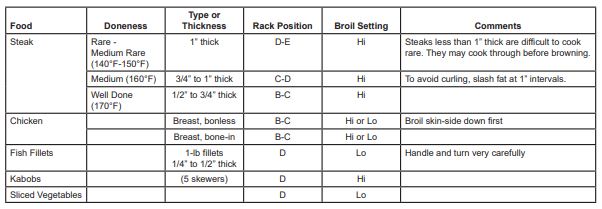
Aluminum Foil
You can use aluminum foil to line the broiler pan and broiler grid. However, you must mold the foil tightly to the grid and cut slits in it just like the grid.
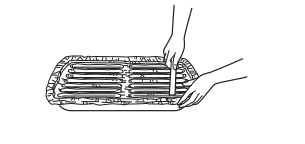
Convection Baking or Roasting
Introduction to Convection Cooking
The reverse-air convection system fan periodically pauses, then changes direction to best distribute hot air throughout the oven. As a result, foods are evenly cooked
and browned—often in less time with convection heat.
NOTE: The convection fan shuts off when the oven door is opened.
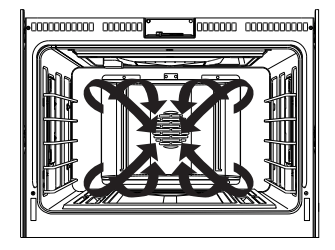
Cookware for Convection Cooking
Before using your convection oven, check to see if your cookware leaves room for air circulation in the oven. If you are baking with several pans, leave space between them. Also, be sure the pans do not touch each other or the walls of the oven. Cookware used in standard BAKE will also work in CONV BAKE. See Baking Tips section.
It is recommended that when baking cookies, the best results are attained with a flat cookie sheet instead of a pan with sides. For recipes like oven-baked chicken, use a pan with low sides. Hot air cannot circulate well around food in a pan with high sides.
Adapting Recipes
You can use your favorite recipes in the convection oven. When convection baking, it may be necessary to reduce the baking temperature by 25°F or to adjust the cooking time. No temperature adjustment is necessary when using CONV ROAST
Some package instructions for frozen casseroles or main dishes have been developed using commercial convection ovens. For best results in this oven, preheat the oven and use the temperature on the package.
Convection Roasting Tips
Use the broiler pan, grid and the roasting rack for best results. Use of the rack will result in improved browning on the underside of meat or poultry.
1. Place the oven rack on a low rack position (A).
2. Place the grid on the broiler pan and put the roasting rack over them.
3. Place meat on the roasting rack.
Optional Accessories
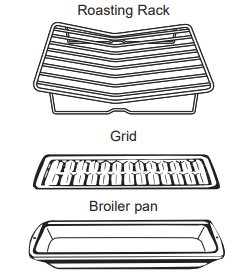
How to Set the Oven for Convection Baking or Roasting
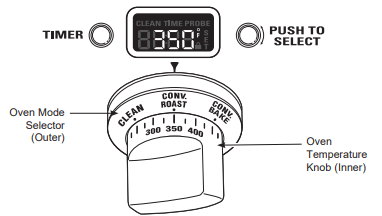
Convection Baking is ideal for evenly browned baked foods cooked on single or multiple racks. Select Convection Roast to roast large, tender cuts of meat uncovered. When set on CONV BAKE or CONV ROAST, the rear convection elements and the fan operate when the oven is heating
1. Turn the Oven Mode Selector to CONV BAKE or CONV ROAST.
2. Using the Temperature knob, set the desired temperature, in 25°F increments, from 175°F to 550°F.
The oven will now begin to preheat. The temperature display will begin at 100°F and remain there until the oven exceeds that temperature. From that point, the display will show the actual temperature.
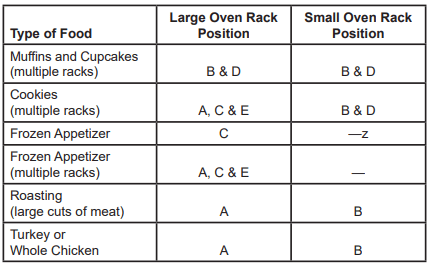
Suggested shelf positions are intended as general guidelines. Experiment with these positions for specific foods and personal preference.
The interior lights will turn on and stay on until the oven is turned off. The convection oven fan will turn on during preheat. The control will beep when the oven is preheated and food can be placed inside the oven.
3. Turn the Oven Mode Selector and the Temperature knob to OFF when convection cooking is finished.
NOTE: A cooling fan will turn on to cool internal parts.
This is normal, and the fan may continue to run even
after the oven is turned off.
Use the temperature probe when a precise internal temperature is important. See Using the probe.

The oven has 5 rack positions. See the Full extension oven racks section for how to use, remove and replace the racks.
The double-oven range has a small oven with 4 rack positions. Rack position C is not in the small oven.
Probe
How to Use the Probe with Bake, Convection Bake and Convection Roast
CAUTION : Use oven mitts when inserting or removing the probe from the hot oven.
Areas around the probe inlet can be very hot.
For many foods, especially roasts and poultry, internal food temperature is the best test for doneness. The temperature probe takes the guesswork out of cooking foods to the exact doneness you want.
The probe can be used with the BAKE, CONV BAKE and CONV ROAST.
1. Push the tip of the probe into the thickest part of the meat.
2. Place the rack in the desired rack position.
3. Set the oven controls. Turn the Oven Mode Selector to CONV BAKE, CONV ROAST or BAKE. Turn the Temperature Knob to desired oven temperature in
25°F increments, from 175°F to 550°F. Allow the oven to preheat if necessary.
The oven and oven lights will turn on immediately and stay on until the oven is turned off.
4. Use oven mitts to place the food in the hot oven.
Insert the plug into the outlet. Make sure it is pushed all the way in. Close the oven door.
5. Turn the Mini-Knob to find the desired internal food temperature. Push the Mini-Knob to select that temperature.
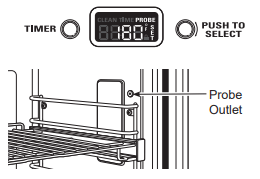
The word PROBE and SET, will flash in the display until a temperature is selected. If no temperature is
set, the probe will default to 100°F. If the oven was not preheated, the display will show LO.
The internal food temperature can be set from a
minimum of 100°F and up to 200°F maximum.
When food reaches the set internal temperature, the display will beep. To stop the reminder beep, turn the Oven Mode Selector and the Temperature Knob to OFF.
Use oven mitts to remove the probe from the oven outlet.
To change the set internal temperature anytime in the cooking process, push the Mini-Knob and turn to adjust the temperature. Press the Mini-Knob to select.
Using the Probe
Use only the probe provided with the range.
Use the handles of the probe and plug when inserting and removing them from the meat and oven outlet.
- To avoid damaging the probe, do not use tongs to pull on the cable when removing it.
- To avoid breaking the probe, make sure food is completely defrosted before inserting.
- To prevent possible burns, always wear an oven mitt when removing the plug; internal oven surfaces may be hot.
- Never leave the probe inside the oven during a broil or self-cleaning cycle.
- Do not store the probe in the oven.
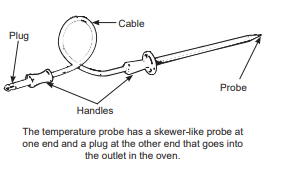
Proper placement of the probe
- Measure the distance to the center of a roast by laying the temperature probe on top of the meat. Use your thumb and forefinger to mark where the edge of the meat will come on the probe.
- Insert the probe up to the point marked with your finger. The tip of the probe should be in the center of the meat.
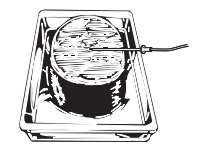
Proofing
How to Set the Oven for Proofing
The proofing feature maintains a warm environment which is useful for rising yeast-leavened dough.
1. Turn the Oven Mode Selector to PROOF. The display will show “PrF”. PROOF mode will not operate when oven is above 125°F. The display will scroll “too hot”. Allow the oven time to cool.
For best results, cover the dough with a cloth or with greased plastic wrap.
Use rack position B or C in the large oven. Use rack position B in the small oven.
The proofing feature automatically provides the optimum temperature for the proofing process; therefore the Temperature knob does not affect the proof temperature.
The oven interior lights cycle on and off as necessary to maintain optimum proof temperature until the Oven Mode Selector has been turned to OFF.
- To avoid lowering the oven temperature and lengthening proofing time, do not open the oven door unnecessarily.
- Check bread products early to avoid over-proofing.
2. When proofing is finished, turn the Oven Mode Selector to OFF

Self-Cleaning Oven
Self-cleaning Safety Precautions
The self-clean oven feature is designed to make cleaning the inside of the oven easy by using very high temperatures to burn away food spills
WARNING : Wipe up excess grease and other food spills with a damp cloth. Excessive food soils can ignite leading to smoke and heat damage.
- Do not clean the oven seals, damage can occur.
- Remove cookware, broiler pan, grid, probe and any aluminum foil from the oven.
- Make sure the oven light lens and lens frame are in place.
- Do not use commercial oven cleaners, abrasives or oven protectors in or near the self-cleaning oven.
- We recommend venting your kitchen with an open
window or using a ventilation fan/hood during the selfclean cycle. - Clean soil from around the frame and from around the oven door, outside the oven seals. These areas must be cleaned by hand.
- The oven racks may be left in the oven during the selfclean cycle.
IMPORTANT: The health of some birds is extremely sensitive to the fumes given off during the selfcleaning cycle of any oven. Move birds to another wellventilated room.
NOTE: During the self-clean cycle, the cooktop will be locked out and not functional. If a surface burner is turned on after the self-clean cycle has begun, a warning will be displayed on the Oven Display “err turn surf frnr off” and a beeping sound will be heard.
NOTE: Self-Clean will not work if the temperature probe is plugged in or if the Sabbath mode is set.
On double oven models, you can set a clean cycle in both ovens at the same time. The last oven set will automatically delay its start until the end of the first oven’s clean cycle.
On double oven models, you can bake in one oven and self-clean in the other at the same time. However, you cannot use the PROOF mode setting in one oven while the other oven is self-cleaning
How to Set the Oven for Cleaning
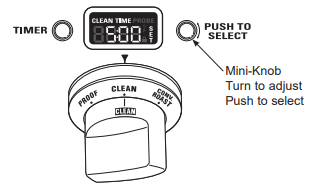
1. Turn off all surface burners. (The CLEAN cycle will not start until all surface burners have been turned off.)
2. Turn the Oven Mode Selector to CLEAN.
3. Turn the Temperature knob to CLEAN.
The control automatically defaults to the recommended clean cycle time of 5 hours. The clean time may be adjusted to any time between 3 and 5 hours using the Mini-Knob. The display will show the actual time remaining.
4. Push the Mini-Knob to start the CLEAN cycle.
If “CLOSE door” scrolls in the display, the self-clean cycle has been selected but the door is not closed. Close the oven door.
The  symbol will flash as the oven door is locked. It will not be possible to open the oven door during the clean cycle.
symbol will flash as the oven door is locked. It will not be possible to open the oven door during the clean cycle.
5. After the clean cycle is complete and the oven has cooled, “End” will show in the display and the  will turn off. Turn the Oven Mode Selector and the Temperature knob to OFF.
will turn off. Turn the Oven Mode Selector and the Temperature knob to OFF.
To interrupt a clean cycle, turn the Oven Mode Selector and the Temperature knob to OFF. When the oven has cooled to a safe temperature, the  symbol will turn off indicating the door may be opened.
symbol will turn off indicating the door may be opened.
An interrupted clean cycle cannot be restarted until after the oven is cool enough for the door to unlock.
After a Clean Cycle
You may notice some white ash in the oven. Wipe it up with a damp cloth after the oven cools. If white spots remain, remove them with warm sudsy water and rinse thoroughly with a vinegar and water mixture. These deposits are usually a salt residue that cannot be removed by the clean cycle.
If the oven is not clean after one clean cycle, repeat the cycle.
Timer
To set the timer:
1. Push the TIMER button.
2. Turn the Mini-Knob to adjust any length of time up to
12 hours and push to select it.
On double oven models, each oven control has its own timer function. Each timer can be set independently.
The control will beep with 1 minute remaining and the display will show seconds until the timer counts down to :00. When the timer reaches :00, the control will beep 3 times followed by one beep every 6 seconds until the Mini-Knob is pushed.
To cancel the timer:
1. Push the TIMER button.
2. Turn the Mini-Knob to :00 and push to select.
To adjust the timer after start:
1. Push the TIMER button.
2. Turn the Mini-Knob to a new desired time and push to select.
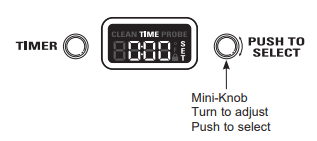
Special Features
Oven Thermostat Adjustment
You may find that your new oven cooks differently than the one it replaced. Use your new oven for a few weeks to become more familiar with it. If you still think your new oven is too hot or too cold, you can adjust the thermostat yourself.
On double oven models, use the large oven controls to enter the mode and to select the adjustment
To adjust the oven thermostat:
1. Push and hold the TIMER button and Mini-Knob at the same time for 4 seconds until the display shows “SF” (Special Features).
2. Turn the Mini-Knob counterclockwise until the display scrolls “OFFSEt”. Push the Mini-Knob to select the offset mode.
3. Turn the Mini-Knob to adjust the oven thermostat up
to 35°F hotter or (-) 35°F cooler in 1°F increments.
3A. On double oven models, you can adjust
the thermostat of the small oven by turning the Mini-Knob above the small oven. Use the large oven Mini-Knob to select that adjustment.

4. Push the Mini-Knob to select your choice and exit the
mode. If you do not wish to save changes, push the
TIMER button to exit at any time.
Sabbath Mode
To set the Sabbath mode:
The Sabbath mode is designed for use on the Jewish Sabbath and other Jewish holidays.
It can be used for baking only. It cannot be used for any other cooking mode.
When the Sabbath feature is set, the oven light and all audible beeps will be disabled. The feature will also
provide a random delay period, of approximately 30 seconds to 1 minute, before the oven will turn on once it is set to BAKE.
1. Push and hold the TIMER button and Mini-Knob at the same time for 4 seconds until the display shows “SF” (Special Features).
2. Turn the Mini-Knob clockwise until the display scrolls “SAbbAtH.” Push the Mini-Knob to select the Sabbath mode.
3. Once “SAbbAtH” is selected, the display will scroll “SAbbAtH ON”.
The Sabbath setting will control both ovens. The symbol J will appear in both oven display windows.
For double oven models, use the large oven control to set the Sabbath feature for both ovens.
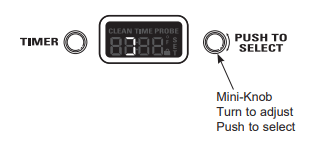
To Cancel the Sabbath Mode:
Repeat steps 1, 2 and 3. The display will scroll “SAbbAtH OFF”.
The oven temperature may be adjusted at any time by turning the temperature knob. There is a random delay before the oven elements respond.
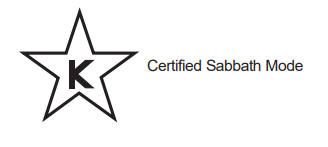
CARE AND CLEANING
Control Panel and Knobs
Be sure all controls are off and all surfaces are cool before cleaning any part of the range
Clean up spatters with a damp cloth. Remove heavier soil with warm, soapy water. Do not use abrasives of any kind on the control panel or knobs. The control knobs may be removed for easier cleaning. To remove a knob, pull it straight off the control panel. Wash the knobs in hot soapy water, but do not soak
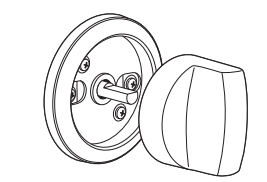
NOTE: The Mini-Knob is not removable.
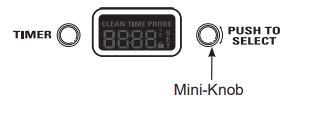
Oven Burners
Do not attempt to clean the IR (Infrared) broil burner. Any soil will burn off when the burner is heated.
The bake burner is not exposed.
Broiler Pan, Grid and Roasting Rack
The broiler pan, grid and roasting rack are all dishwasher safe. However, baked on foods may require washing by hand with a commercial oven cleaner or abrasive detergent. Do not store a soiled broiler pan or grid anywhere in the oven. Always properly dispose of excess grease.
CAUTION : Do not clean the broiler pan, grid or roasting rack in a self-cleaning oven.
Optional Accessories
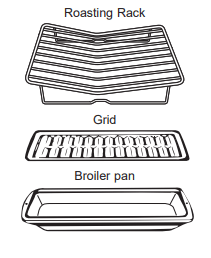
Oven Racks
The racks may remain in the oven during the selfcleaning cycle without being damaged.
Periodically, after several self-clean cycles, the oven racks may need to be lubricated using the Graphite Lubrication shipped with your range. To order additional Graphite Lubrication, call our National Parts Center at 800.626.2002 and reference WB02T10303.
1. Remove rack from the oven. See the Full extension oven racks section.
2. Fully extend the rack on a table or countertop. Newspaper may be placed underneath the rack for easy cleanup.

3. If there is debris in the slide tracks, wipe it away using a paper towel.
NOTE: Any graphite lubricant wiped away must be replaced.
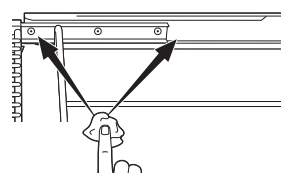
4. Shake the graphite lubricant before opening it. Starting with left slide mechanism of the rack, place four (4) small drops of lubricant on the two (2) bottom tracks of the slide close to the bearing carriers

5. Repeat for the right slide mechanism of the rack

6. Open and close the rack several times to distribute the
lubricant.
7. Replace the cap on the lubricant and shake it again.
Turn the rack over and repeat steps 3, 4, 5 and 6.
8. Close the rack, turn rack right-side-up and place in the
oven. See the Full extension oven racks section.
9. Repeat above steps for each rack.
Low Profile Oven Rack
The gray porcelain-coated low profile rack may remain in the oven during the self-cleaning cycle without being damaged. It may also be cleaned using a mild abrasive cleanser. After cleaning, rinse the rack with clean water and dry with a clean cloth. Periodically and after clean cycles, the low profile rack may need to be lubricated to aid sliding. Wipe the rack edges or oven rack supports with the Graphite Lubrication shipped with your range or vegetable oil.
To order additional Graphite Lubrication, call our National Parts Center at 800.626.2002 and reference WB02T10303

Lift-off Oven Door
The door is very heavy. Be careful when removing and lifting the door. Do not lift the door by the handle.
To remove the door:
1. Fully open the door.
2. Pull the hinge locks down toward the door frame, to the unlocked position. A tool, such as a small flat-blade screwdriver, may be required.
3. Firmly grasp both sides of the door at the top.
4. Close door to the door removal position,
(approximately 15 degrees from closed) and lift it up and out until the hinge arm is clear of the slot.
To replace the door:
1. Firmly grasp both sides of the door at the top.
2. With the door at the same angle as the removal position, seat the indentation of the hinge arm into the bottom edge of the hinge slot. The notch in the hinge arm must be fully seated into the bottom of the slot.
3. Fully open the door. If the door will not fully open, the indentation is not seated correctly in the bottom edge of the slot.
4. Push the hinge locks up against the front frame of the oven cavity, to the locked position.
5. Close the oven door.
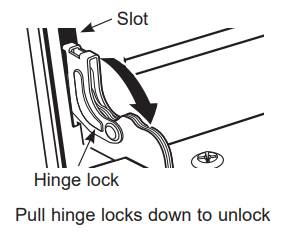
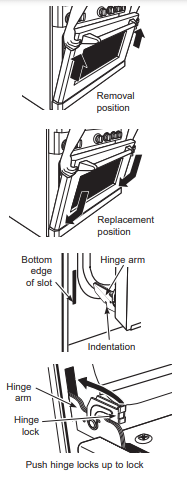
Probe
Allow the temperature probe to cool before cleaning. The probe should be cleaned with soap and water by hand. Do not immerse the temperature probe in water. Do not store the temperature probe in the oven. Do not clean the temperature probe in the self-cleaning oven.
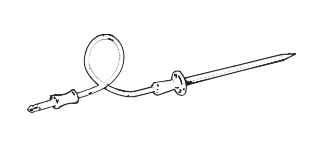
Oven Lights
WARNING : SHOCK OR BURN HAZARD: Before replacing oven light bulb, disconnect the electrical power to the range at the main fuse or circuit breaker panel. Failure to do so may result in electric shock or burn.
CAUTION : BURN HAZARD: The glass cover and bulb should be removed when cool. Touching hot glass with bare hands or a damp cloth can cause burns.
Each oven is equipped with halogen light columns located on the side walls of the oven. The lights come on when the door is opened or when the oven is in a cooking cycle.
Each light assembly consists of a removable light cover with two locking clips and a light compartment with three halogen bulbs.
Be sure to let the light cover and bulb cool completely. For your safety, do not touch a hot bulb with bare hands or a damp cloth.
To remove:
1. Remove the racks from the oven. See the Full extension oven racks section.
2. Using a 7/16" nutdriver, remove the four nuts holding the rack supports to the oven wall.

3. Remove the glass light cover by pulling its back edge out and rolling it toward you. Do not remove any screws.
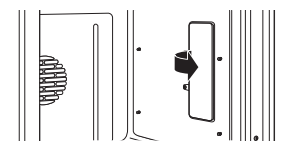
4. Using gloves or a dry cloth, remove the burned-out light bulb by pulling it straight out.
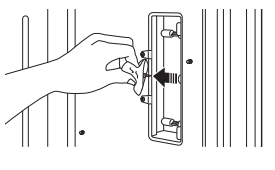
To replace:
Use a new 120-volt Halogen bulb, with G8 pins, not to exceed 25 watts.

Replacement bulbs may be purchased by calling 800.626.2002. Order Part Number WB25T10064
NOTE: Higher-wattage bulbs will damage your oven. Using gloves or a dry cloth, remove the bulb from its packaging. Do not touch the bulb with bare fingers. Oil from bare fingers may cause hot spots on the glass surface and lead to premature failure of the bulb. If you do touch the glass, clean it with alcohol prior to installation.
1. Push the bulb straight into the receptacle all the way
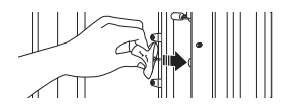
2. Replace the light cover, by placing its front edge under the front two tabs in the light compartment. Roll the back edge into place, making sure that it is firmly seated.
NOTE: If the locking clips fell from the glass lens cover, hold them on the cover, in the correct position, while replacing the cover on the light compartment.
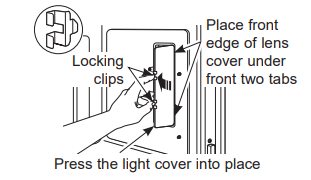
The light cover must be in place when using the oven.
3. Reinstall the rack support. Be sure to orient the support so that the top tabs for the nuts are closest to the top of the oven. Lightly secure with the four nuts removed earlier, but do not over-tighten or the enamel could be chipped.
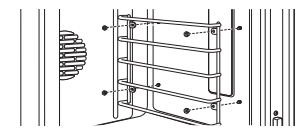
4. Replace the racks. See the Full extension oven racks section.
5. Reconnect electrical power to the oven.
Surfaces
Oven Door
The oven frame and door, outside the oven seals, should be cleaned by hand. Enameled surfaces should be cleaned with hot soapy water. See Stainless Steel Surfaces section for all Stainless Steel areas
Do not rub or clean the door seal—the fiberglass material of the seal has an extremely low resistance to abrasion. An intact and well-fitting oven seal is essential for energy-efficient operation and good baking results. If the seal becomes worn, frayed, damaged or displaced it must be replaced by a qualified technician.
Stainless Steel Surfaces
Do not use a steel-wool pad; it will permanently scratch the surface. To clean the stainless steel surface, use warm sudsy water or a stainless steel cleaner. Always wipe the surface in the direction of the grain. Follow the cleaner instructions for cleaning the stainless steel surface.
To inquire about purchasing stainless steel appliance cleaner, please call our toll-free number, 800.626.2002
Oven bottom
The oven bottom has a porcelain enamel finish. To make cleaning easier, protect the oven bottom from excessive spillovers. A smaller sheet of foil or sheet tray may be used to catch a spillover by placing it on the rack below the rack you are cooking on. This is particularly important when baking a fruit pie or other foods that are highly acidic. Hot fruit fillings or other foods that are highly acidic (such as tomatoes, sauerkraut and sauces with vinegar or lemon juice) may cause pitting and damage to the porcelain enamel surface and should be wiped up immediately. Never fully cover a rack with aluminum foil. This will disturb the heat circulation and result in poor baking. To clean up spillovers, use soap and water, an abrasive cleaner or soap-filled scouring pad. Rinse well to remove soap before self-cleaning.
Dual-flame Stacked Burners
The burner consists of three parts: the burner base, burner head, and burner cap. The burner head and burner cap can be lifted off, making them easy to clean.
CAUTION : DO NOT OPERATE THE BURNER WITHOUT ALL BURNER PARTS IN PLACE.
Surface burners should be cleaned routinely, especially after bad spillovers, which could clog the slots and holes in the burner heads.
The electrode is located at the rear of each burner. Do not attempt to disassemble or clean around any burner while another burner is on. An electric shock may result.
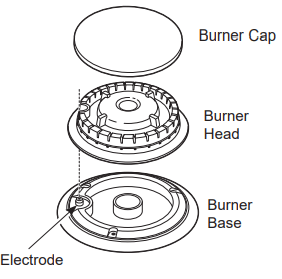
To remove the burner parts:
1. Turn all controls OFF before removing any burner parts
2. When cool, you may lift off the burner grates, burner caps and burner heads for easier cleaning. Do not remove the burner bases.
Cleaning
Lift off burner parts only when cool. Wash in hot, soapy water. You may use a plastic scouring pad to remove burned-on food particles.
To remove burned-on food, soak the burner heads in a solution of mild liquid detergent and hot water for
20-30 minutes. For more stubborn stains, use a plastic scouring pad or toothbrush.
If the spill goes inside the burner head assembly, wash it under running water and shake to remove excess water.
After Cleaning
Before replacing the burner parts, shake out excess water and then dry them thoroughly.
To replace the burner parts:
Make sure that the burner parts are replaced in the correct location.
1. Replace the burner head on top of the burner base, making sure that the hole in the burner head is properly aligned with the electrode in the burner base. A small gap between the base and head is normal.
2. Place the burner cap on top of the burner head. Make sure that the burner cap is properly seated on the burner head.
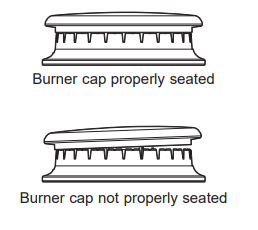
Spark Igniter and Electrodes
The electrode of the electronic ignition system is positioned at the rear of the burner base. When cleaning the cooktop, be careful not to snag the igniter with your cleaning cloth. Damage to the igniter could occur. Be careful not to push in a control knob while cleaning. It could cause the igniter to spark. Make sure that the white ceramic igniters on the cooktop are dry and clean. Clean the metal portion of the electrode with a soft cloth or emery board. Do not attempt to remove the electrode from the cooktop.
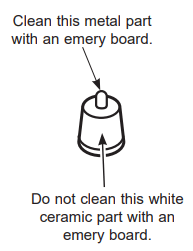
Burner Grates
The enameled cast-iron burner grates should be cleaned regularly. You must put the grates on the self-clean oven rack during the self-clean cycle. DO NOT put the grate on the oven floor during a self-clean cycle. DO NOT put the frame inside the oven during a self-clean cycle. Only the grate can withstand the heat of the self-clean cycle. The frames may be cleaned by hand or in the dishwasher. Wash them in hot soapy water, rinse, and dry thoroughly. Although they are durable, the grates will gradually lose their shine, regardless of the best care you can give them. This is due to their continual exposure to high temperatures. Do not operate a burner for an extended period of time without cookware on the grate. The finish on the grate may chip without cookware to absorb the heat.
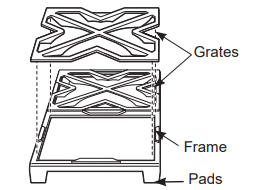
For stability, the frames have rubber pads on each corner. During cleaning and use, be careful not to damage or snag rubber pads.
Grease Troughs (on some models)
Grease from the griddle will drain into the enameled cast-iron grease troughs at the front of the range. Once the troughs have cooled, they may be lifted out for easier cleaning. To remove the cool grease trough from the griddle, slide it toward the front and lift up. Do not allow grease to accumulate in the grease troughs as it can be a fire hazard. Clean the grease troughs as soon as they are cool. The grease troughs can be cleaned by hand with hot soapy water or in the dishwasher. Wipe any spillage in the trough basin with a soft cloth. For stability, the troughs have rubber pads at the front. Be careful not to damage the pads when removing for cleaning
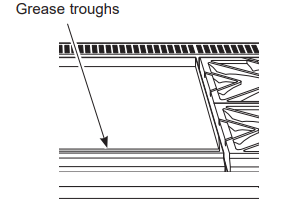
Griddle (on some models)
Thoroughly clean the griddle of grease and food particles, using a square-edged metal spatula, while it is still hot. Wipe the griddle with a dry, heavy, coarse cloth to remove any remaining residue and food particles. If the griddle is cleaned with anything other than a dry, heavy, coarse cloth, it will need to be reseasoned. Never flood the hot griddle with cold water. This could cause the griddle to crack or warp.
Cutting Board (on some models)
Wash the bamboo cutting board with warm water and a mild soap. Occasionally, wipe it with mineral oil. Do not clean the cutting board in the dishwasher.
Optional Accessories
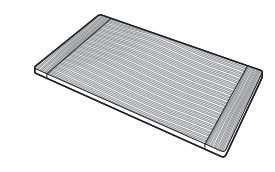
TROUBLESHOOTING TIPS
| Problem | Possible Cause |
| Oven Will Not Work | A fuse in your home may be blown or the circuit breaker tripped. The oven controls are not properly set. The oven controls are set for cleaning. If necessary, allow the oven to cool; then open the door. Make sure the Oven Mode Selector is set to BAKE and the Temperature knob is set to a temperature. |
| Surface Burners Light But Oven Does Not | The oven gas shut-off valve may have accidentally been moved during cleaning or moving. |
| Oven Light(S) Do Not Work | The light bulb is defective. Replace the bulb. The oven is self-cleaning or the Sabbath feature is set. The oven lights do not come on during selfcleaning or if the Sabbath feature is set. The oven is set for Proof mode. The lights cycle on and off as necessary to maintain Proof temperature |
| Food Does Not Bake Or Roast Properly | The oven controls are improperly set. See the Baking or Roasting section. Oven not preheated for a long enough time; wait for the oven to signal preheat. Incorrect cookware or cookware of improper size being used. See Baking Tips. Racks in the wrong position. See the Baking or Roasting section. Use a foil tent to slow down browning during roasting. Oven thermostat needs adjustment. See the Oven thermostat adjustment section |
| Food Does Not Broil Properly | This model is designed for closed door broiling only. Close the door. Always broil with the door closed. The oven controls are not set at BROIL. See the Broiling section. The probe is plugged into the outlet in the oven. Remove the probe from the oven. Improper rack position being used. Cookware is not suited for broiling. Use the broiling pan and grid that came with your oven. Aluminum foil used on the broiling pan and grid has not been fitted properly and slit as recommended. |
| Oven Will Not Self Clean | The oven temperature is too high to set a self-clean operation. Allow the oven to cool below the locking temperature and reset the controls. The controls are not properly set. See the Self-Cleaning Oven section |
| Cracking Or Popping Sound During Cleaning | This is normal. This is the sound of the metal heating and cooling during both the cooking and cleaning functions. |
| Excessive Smoking Occurs During Cleaning | The oven is heavily soiled. Turn the Oven Mode Selector and the Temperature knobs to OFF. Open the windows to rid the room of smoke. Wait until the locked door indicator light goes off. Wipe up excess soil and reset the clean cycle. |
| Oven Not Clean After A Clean Cycle | The oven was heavily soiled. Clean up heavy spillovers before starting the clean cycle. Heavily soiled ovens may need to self-clean again. Oven is connected to a 208V electrical supply. Set your cleaning time for 5 hours. The oven controls are not properly set. See the Self-Cleaning Oven section. |
| Oven Racks Are Difficult To Slide | The racks were cleaned in the self-clean cycle and now need periodic lubrication. Do not spray with a cooking spray or other lubricant sprays. See Full extension oven racks in the Care and Cleaning section. |
| Timer Does Not Work | The timer cannot be used while the oven is self-cleaning. |
| Oven Temperature Too Hot Or Too Cold | Oven thermostat needs adjustment. See the Oven thermostat adjustment section. |
| Oven Door Will Not Open After A Clean Cycle | The oven is too hot. Allow the oven to cool below locking temperature. |
| “Err Turn Surface Burners Off” Scrolls In The Display | Self-clean is in progress and the Cooktop Lockout feature is activated. No surface cooking is permitted during the self-clean operation. Wait until the self-cleaning operation has been completed. |
| “Close Door” Scrolls In The Display | The self-clean cycle has been selected but the door is not closed. Close the oven door. The |
 Is On When You Want To Cook Is On When You Want To Cook | The oven door is locked because the temperature inside the oven has not dropped below the unlocking temperature. Turn the Oven Mode Selector and the Temperature knobs to OFF. Allow the oven to cool. |
| F- And A Number Flash In The Display | The oven has a function error code. Turn the Oven Mode Selector and the Temperature knobs to OFF. Allow the oven to cool for one hour. Put the oven back into operation. Disconnect all power to the oven for 30 seconds and then reconnect power. If the function error code repeats, call for service. |
| Display Goes Blank | The display is blank when the oven or timer is not in use. A fuse in your home may be blown or the circuit breaker tripped. Replace the fuse or reset the circuit breaker. |
| Unable To Get The Display To Show “Sf” | The TIMER and the MINI-KNOB buttons must be pushed at the same time and held for 4 seconds. |
| “Probe” Appears In The Display | This is reminding you to enter a probe temperature after plugging in the probe. Enter a probe temperature |
 Shows In Display Shows In Display | The Sabbath mode has been selected. |
| Power Outage | If the oven was in use during a power outage or surge, the oven must be reset. Turn the Temperature knob and the Oven Mode Selector to OFF. Reset the controls to begin again. |
| Steam From The Vent | When using the convection mode, it is normal to see steam coming out of the oven vent. As the number of racks or amount of food being cooked increases, the amount of visible steam will increase. |
| Burning Or Oily Odor Emitting From The Vent | This is normal in a new oven and will disappear in time. |
| Strong Odor | This is temporary. An odor from the insulation around the inside of the oven is normal for the first few times the oven is used. |
| Fan Noise | A cooling fan or a convection fan (depending on the function you are using) may turn on. This is normal. The cooling fan will turn on to cool internal parts. It may run after the oven is turned off. The convection fan may cycle on and off until the function is over or the door is opened. |
| Convection Fan Not On All The Time | The convection fan (depending on the function you are using) may cycle on and off until the function is over or the door is opened for optimized performance. This is normal. In addition, the convection fan may cycle in the clockwise and counter clockwise direction until the function is over or the door is opened. |
| Burners Do Not Light Or Spark Randomly | Electrical plug is not plugged into a live power outlet. Gas supply not turned on. Burner parts not replaced correctly. Holes in the simmer rings or slits in the burner rings are clogged. Clogged orifice, or wet burners or electrodes. Cooktop Lockout feature is activated. A fuse in your home may be blown or circuit breaker tripped. |
| Burners Have Yellow Or YellowTipped Flames | Burner parts not replaced correctly
If burner flames look like (A), call for service. Normal burner flames should look like (B) or (C), depending on the type of gas. |
| Burner Flames Very Large Or Yellow | The range may be connected to the wrong fuel type. Contact the person who installed your range or made the conversion |
| Burner Control Knob Will Not Turn | When the knob is at the OFF position, it must be pushed in before it can be turned, and it can only be turned in a counterclockwise direction. When the knob is at any other position, it can be turned in either direction without being pushed inwards. |
| Condensation Or Fogging On The Inner Door Glass | Condensation or fogging on the inside of the oven door glass is normal during the preheating of the oven and will evaporate usually by the end of the preheating cycle. |
| Burner Flames contain Flickers of Orange | Airborne dust; cool-mist humidifier; debris on or inside burner. |
See other models: RGB508PEH2CT GSS22UFPACC PSF26NGWABB PD900DP1WW RGB518PCH1CT

